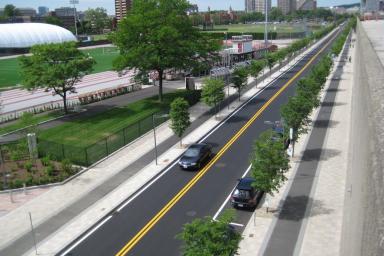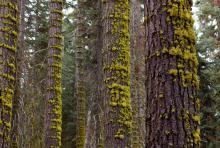In 2016, MITOS, the Office of Campus Planning, and its partners began the development of a plan to enhance the productivity of the campus’ built and ecological systems to capture, absorb, re-use and treat stormwater.

From a semi-industrial landscape to a densely populated center of innovation, our campus landscape has undergone dramatic evolution since MIT moved across the Charles River to Cambridge in 1916. Currently, approximately 64 percent of MIT’s campus is composed of impervious surfaces, such as roofing and paving. Green spaces provide areas for recreation and habitats for local wildlife. They also clean the air by absorbing carbon dioxide and provide natural water management, actively mitigating the effects of climate change.
Rain falling on the campus' hardscapes results in stormwater runoff that flows into the municipal drainage system and eventually discharges into the Charles River. Over the past decade, MIT has worked to incorporate more green spaces into the campus landscape and plan new construction to minimize impact on the surrounding natural environment.
With its volatile and variable weather patterns and its extremes of heat and cold, the Northeastern United States is an ideal test bed for exploring solutions to our stormwater and landscape challenges. At the MIT Office of Sustainability (MITOS), we’re working with our partners to use our campus as a test bed to investigate how we can create and restore landscapes that mitigate our impact on the environment and promote healthy communities.
Here are just a few of the landscape strategies we’re advancing:
create an ecologically resilient community that benefits the environment and the people who live and work in it
reduce water demand and energy consumption
filter and decrease the amount of stormwater runoff
improve air quality and decrease noise pollution
MITOS is currently working collaboratively to transform the sustainability of the campus landscape via operations, education, research, and innovation in the following areas.
In 2016, MITOS, the Office of Campus Planning, and its partners began the development of a plan to enhance the productivity of the campus’ built and ecological systems to capture, absorb, re-use and treat stormwater.
In November 2015, the MIT Office of Sustainability released the first set of recommendations, generated by the 2014-2015 Sustainability Working Groups, which address the following topics: building design and construction; stormwater and land management; materials management; and green labs.
MITOS is part of a community of departments, labs, and centers working toward elements of a sustainable campus. Featured below are initiatives from some of our partners.

Grounds Services maintains green spaces throughout campus for the community to relax, revive, or eat lunch outdoors.

Interactive mapping tool from MIT’s Senseable City Lab to evaluate and compare canopy cover in cities around the world.
Serve as stewards of the evolving physical campus and provides services that guide and inform campus strategy and transformation.
Maintains the Institute's outdoor areas and provides a clean, comfortable, and functional environment for the community.
Students learn to apply advanced analysis and design to understand and solve pressing urban and environmental problems.